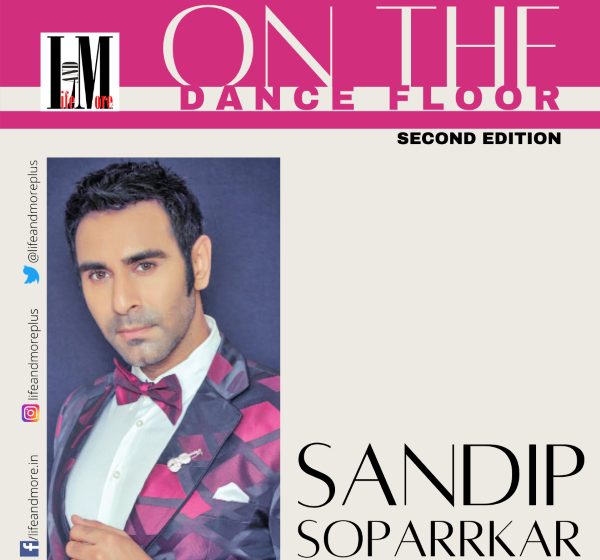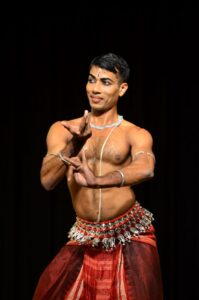Rahul Acharya, an Odissi exponent who wins hearts hands down

Rahul Acharya, 40, is a Bhubaneshwar-based Odissi dancer and a renowned scholar who has won many awards and rewards. I chatted with this supremely talented dancer who discussed everything with me about right from his devotion towards Odissi dance to his life surrendered to the rich Indian art, culture and tradition.
What motivated you to take up Odissi? Tell us about your training schedule.
I started training at a very young age at 3. My sister and my cousins would go to learn from Guruji (later also my Guru Sri Durga Charan Ranbir) and since I had no one to spend time with, I started accompanying them. That is how my Guru handpicked and moulded me. Coming from a family of Rajgurus, I imbibed the traditional family values and was exposed to the modern world by a bureaucratic father and an engineer mother. Dance happened very naturally I guess, as I was blessed to see the temple dancers of Puri (the Maharis) from very close quarters, the way they rendered their service, their surrender, it had tremendous amount of impact on me.
Tell us more about your gurus and what you learnt from them?
My Guru, Durga Charan Ranbir, is one of the foremost surviving Gurus of Odissi. I was an extremely notorious kid and hyper energetic. The only people who had the capacity to tackle me, were my mother and my Guru. These were the only two people I was petrified of. Guruji’ patience in dealing with a difficult person like me, is indeed commendable. It’s been over three decades that the Guru Shishya relationship is still intact. Guruji has a major role to play in my personal life. A true Guru in every sense, he has inculcated in me, the concept of samarpana to dance. That is probably why I have not been able to visualise a mundane life for myself. Dance for me is sadhana, my process of self realisation.
Odissi Exponent Rahul Acharya. Photo Courtesy : Debajyoti Dhar
How difficult is it for a male dancer to survive in a world dominated by female dancers?
Classical dancing in India was always considered a taboo for males. Most of the male dancers did not come with a strong support system. In India, where patriarchy is a social norm and women were expected to be house makers, usually depended on the male members and the male members of the family had to play the role of bread winners, it was much easier for females to think of an alternative career which was not so well paying.
But we forget that all our acharyas have been men. They were the ones who taught the dances and trained the performers.
While things are slowly changing for good, it is still difficult to survive only as a performer – there aren’t too many stage shows and not too many takers for classical dance and not too many takers for male dancers. Unless one is exceptionally striking and has something more to offer, it is very difficult to survive as a male soloist.
Fortunately for me, I did not face discrimination owing to a strong academic background. I have always fared well as an academician and had a different career choice as a scientist. I had not chosen to take dance as a career, but it engulfed me completely. It possessed my entire being. I have received tremendous amount of support from the dance fraternity.
Who do you credit your success to and who have been you biggest support in this dance journey?
Guru Ratikant Mohapatra has always been the big brother, being instrumental in shaping up my career and giving it an academic angle. My Sanskrit Guru, Pandit Nityananda Mishra has taken the pains of educating me in the theoretical aspects. My Guru, Sri Durga Charan Ranbir was the one who offered me my career, serving it on a golden platter. I just had to grab it. My pillar of strength was always my mother, Binapani Sahoo, who not only verbally supported my career but provided the finances to keep it going. Besides I was always in my own league and I never competed with anyone. I only grabbed the best and kept working on myself.
You are one of the rare male dancers who has a super fit and chiselled body, from where does that inspiration come?
The urge to get better and serve dance. My body is my temple and for every dancer that is the case. The body needs to be taken care of and constantly honed. As the Kathopanishad states, the body is the chariot and the Atma is the passenger. I need to keep my chariot in top shape for smoothening the journey of my Atma.
Tell me about your recent unpleasant encounter at the Konark festival, what happened?
It was a very unfortunate incident, where a young dancer sitting beside me was asked to vacate the chair while the programme was going on to accommodate a seat for some family member of some bureaucrat who had not even come. I raised my voice and left place and complained to the top officials of the government. How can we promote tourism in our state when we lack basic ethics of respecting our own people? Like charity, samskara begins at home. How can I claim atithi devobhava if I lack basic manners towards my own people? Are security people paid a salary to serve the family members of bureaucrats? Should the PM’s wife also be treated as PM? This was the issue I raised.
How has the covid times enriched you?
No rest in the kingdom. There are miles to go before I sleep and miles to go before I sleep. Though Covid hasn’t affected me much as classes at the university, where I teach, went on irrespective of the lockdown. The only paradigm shift being from the real to the virtual. Working hours haven’t reduced at all and responsibilities have increased for sure.
What are your future plans to take Oddisi dance to more people?
To die dancing. I am only a very ordinary dancer and certainly not indispensable. There are millions like me who come and go every day. Odissi hasn’t ceased. Great Gurus and dancers have come and gone, yet Odissi lives on. All I can plan is to learn to surrender to Odissi and be grateful that I am one of the chosen few to be able to surrender myself to Odissi.


